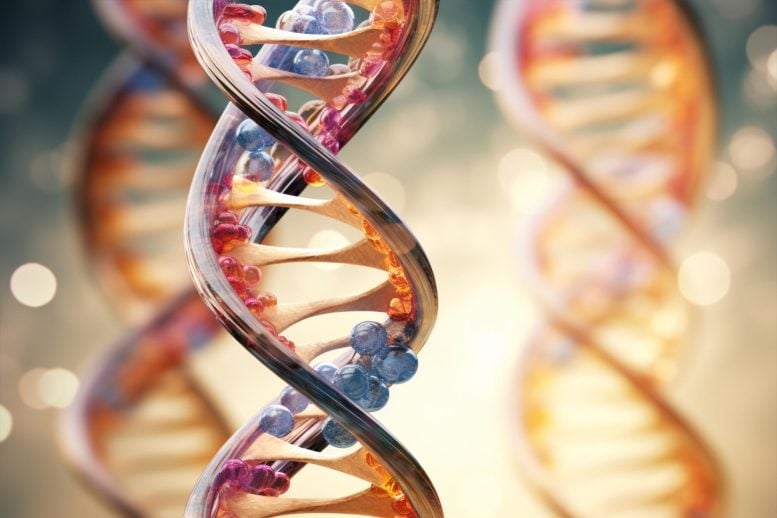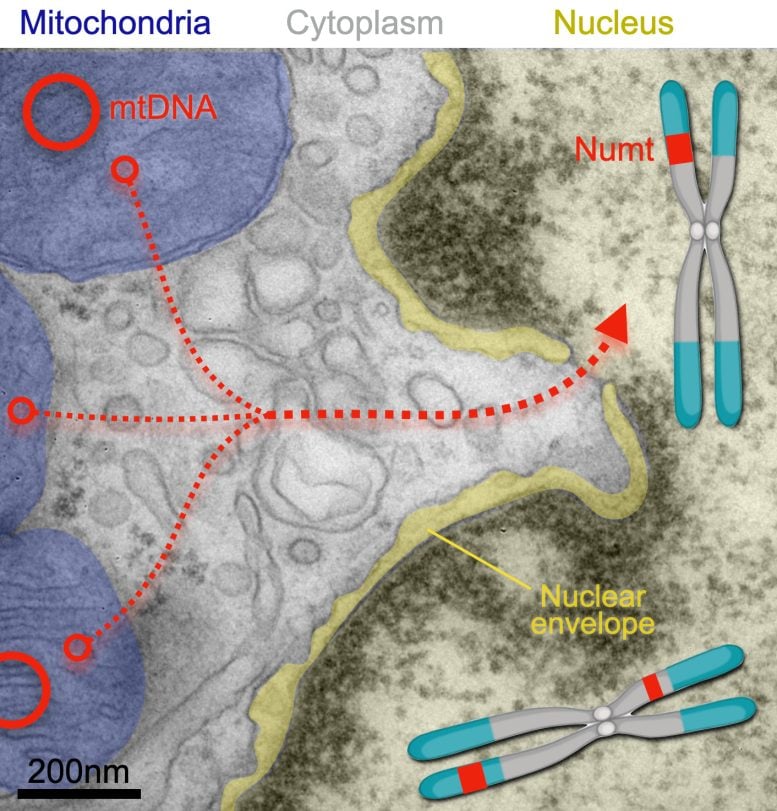
According to research, these mitochondrial DNA insertions may be associated with early death.
Mitochondria in brain cells often enter their own DNA in the nucleus, potentially affecting lifespan, as those with more insertions were found to die earlier. Stress appears to accelerate this process, suggesting a new way mitochondria affect health beyond energy production.
As direct descendants of ancient bacteria, mitochondria have always been a bit of an outsider. Now a study shows that mitochondria may be even stranger than we thought.
Mitochondria in our brain cells often dump their DNA into the nucleus, the study found, where the DNA integrates into the cells’ chromosomes. And these insertions can cause harm: Among nearly 1,200 study participants, those with more mitochondrial DNA insertions in their brain cells were more likely to die earlier than those with fewer insertions.
“We thought that the transfer of DNA from mitochondria to the human genome was a rare occurrence,” says Martin Picard, a mitochondrial psychobiologist and associate professor of behavioral medicine at Columbia University’s Vagelos College of Physicians and Surgeons and at the Robert N. Butler. Columbia Center on Aging. Picard led the study with Ryan Mills of the University of Michigan.
“It’s amazing that it seems to happen several times in a person’s lifetime,” Picard adds. “We found many of these insertions in different regions of the brain, but not in blood cells, explaining why dozens of previous studies analyzing blood DNA missed this phenomenon.”
Mitochondrial DNA behaves like a virus
Mitochondria live inside all of our cells, but unlike other organelles, mitochondria have their own DNA, a small circular strand of about three dozen genes. Mitochondrial DNA is a holdover from the organelle’s ancestors: the ancient bacteria that settled within our single-celled ancestors about 1.5 billion years ago.
In recent decades, researchers discovered that mitochondrial DNA occasionally “jumped” out of the organelle and into human chromosomes.

“Mitochondrial DNA behaves similarly to a virus in that it uses cuts in the genome and attaches itself, or like jumping genes known as retrotransposons that move around the human genome,” says Mills.
The insertions are called nuclear-mitochondrial segments – NUMTs (“new ticks”) – and have been accumulating in our chromosomes for millions of years.
“As a result, all of us are walking around with hundreds of leftover, mostly benign, segments of mitochondrial DNA in our chromosomes that we inherited from our ancestors,” says Mills.
Mitochondrial DNA insertions are common in the human brain
Research in just the last few years has shown that “NUMTogenesis” is still happening today.
“Mitochondrial DNA jumping is not something that only happened in the distant past,” says Kalpita Karan, a postdoc in the Picard lab who conducted the research with Weichen Zhou, a research investigator in the Mills lab. “It’s rare, but a new NUMT integrates into the human genome about once every 4,000 births. This is one of the many ways, conserved from yeast to humans, by which mitochondria talk to nuclear genes.
The realization that new inherited NUMTs are still being created led Picard and Mills to wonder whether NUMTs might also be born in brain cells during our lifespan.
“Inherited NUMTs are mostly benign, probably because they arise early in development and the harmful ones have disappeared,” says Zhou. But if a piece of mitochondrial DNA gets inserted into a gene or regulatory region, it can have significant consequences on that person’s health or lifespan. Neurons may be particularly susceptible to damage caused by NUMTs because when a neuron is damaged, the brain does not usually create a new brain cell to take its place.
To examine the extent and impact of the new NUMTs in the brain, the team worked with Hans Klein, assistant professor at the Center for Translational and Computational Neuroimmunology at Columbia, who had access to DNA sequences from participants in the ROSMAP aging study (led by David Bennett at Rush University). The researchers looked for NUMT in different brain regions using tissue samples collected from more than 1,000 older adults.
Their analysis showed that the insertion of nuclear mitochondrial DNA occurs in the human brain – mainly in the prefrontal cortex – and likely several times during a person’s lifetime.
They also found that people with more NUMT in their prefrontal cortex died earlier than individuals with less NUMT. “This suggests for the first time that NUMTs can have functional consequences and possibly affect lifespan,” says Picard. “NUMT accumulation may be added to the list of genome instability mechanisms that may contribute to aging, functional decline, and longevity.”
Stress accelerates NUMTogenesis
What causes NUMTs in the brain and why do some regions accumulate more than others?
To get some data, the researchers looked at a population of human skin cells that can be cultured and aged in a dish for several months, enabling remarkable longitudinal “span” studies.
These cultured cells gradually accumulated several NUMT per month, and when the cells’ mitochondria were dysfunctional from stress, the cells accumulated NUMT four to five times faster.
“This shows a new way in which stress can affect the biology of our cells,” says Karan. “Stress makes mitochondria more likely to release pieces of their DNA, and these pieces can then ‘infect’ the nuclear genome,” adds Zhou. It’s just one way mitochondria shape our health beyond energy production.
“Mitochondria are cellular processors and a powerful signaling platform,” says Picard. “We knew they could control which genes are turned on or off. We now know that mitochondria can even change the nuclear DNA sequence itself.”
Reference: “Somatic Insertions of Nuclear Mitochondrial DNA Are Widespread in Human Brain and Accumulate Over Time in Fibroblasts” by Weichen Zhou, Kalpita R. Karan, Wenjin Gu, Hans-Ulrich Klein, Gabriel Sturm, Philip L. De Jager, David A. Bennett, Michio Hirano, Martin Picard, and Ryan E. Mills, 22 Aug 2024, PLOS Biology.
DOI: 10.1371/journal.pbio.3002723
This work was supported by grants from the USA National Institutes of Health (R01AG066828, R21HG011493 and P30AG072931), the Baszucki Brain Research Fund and the University of Michigan Alzheimer’s Berger Endowment Disease Center.